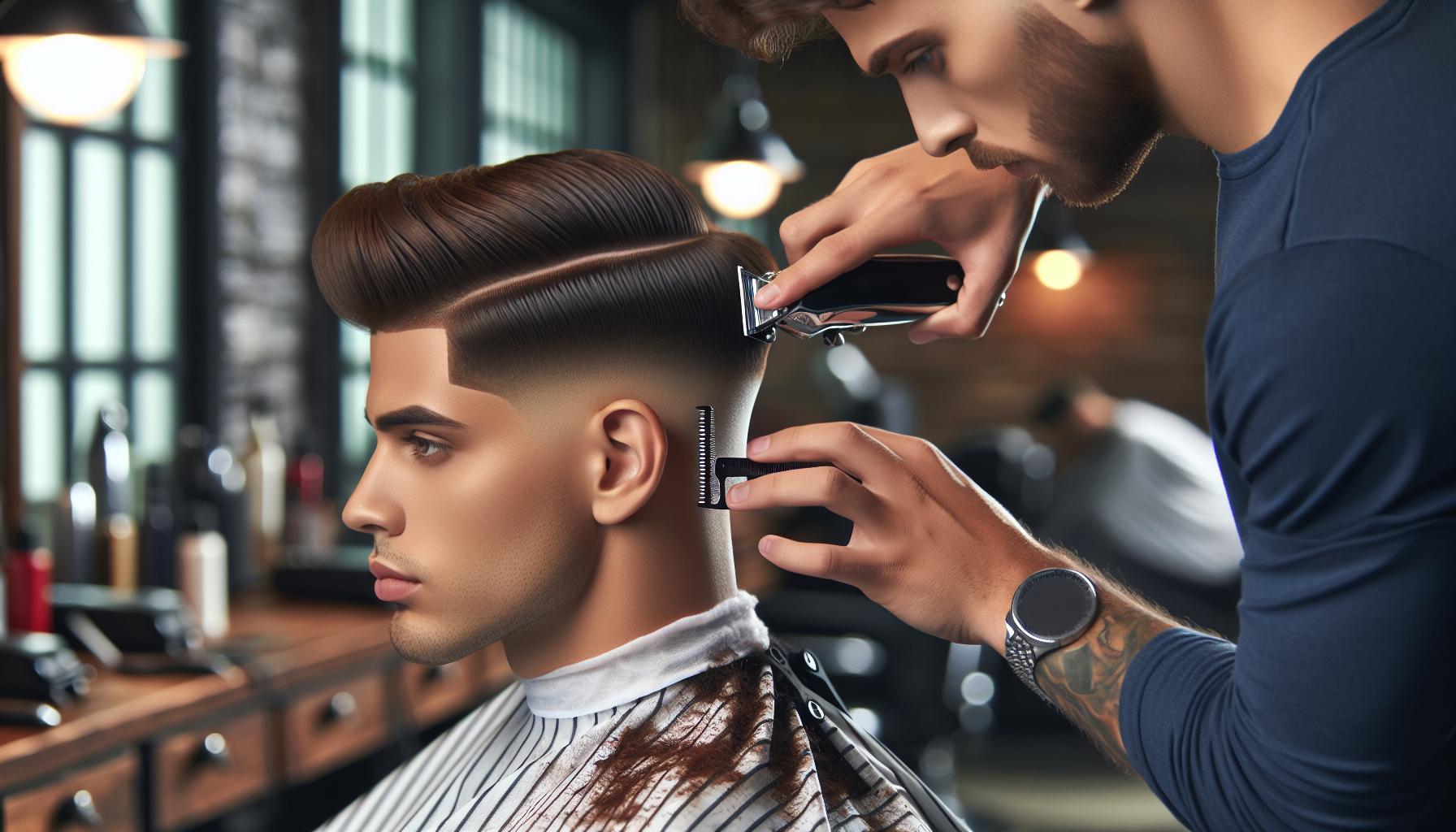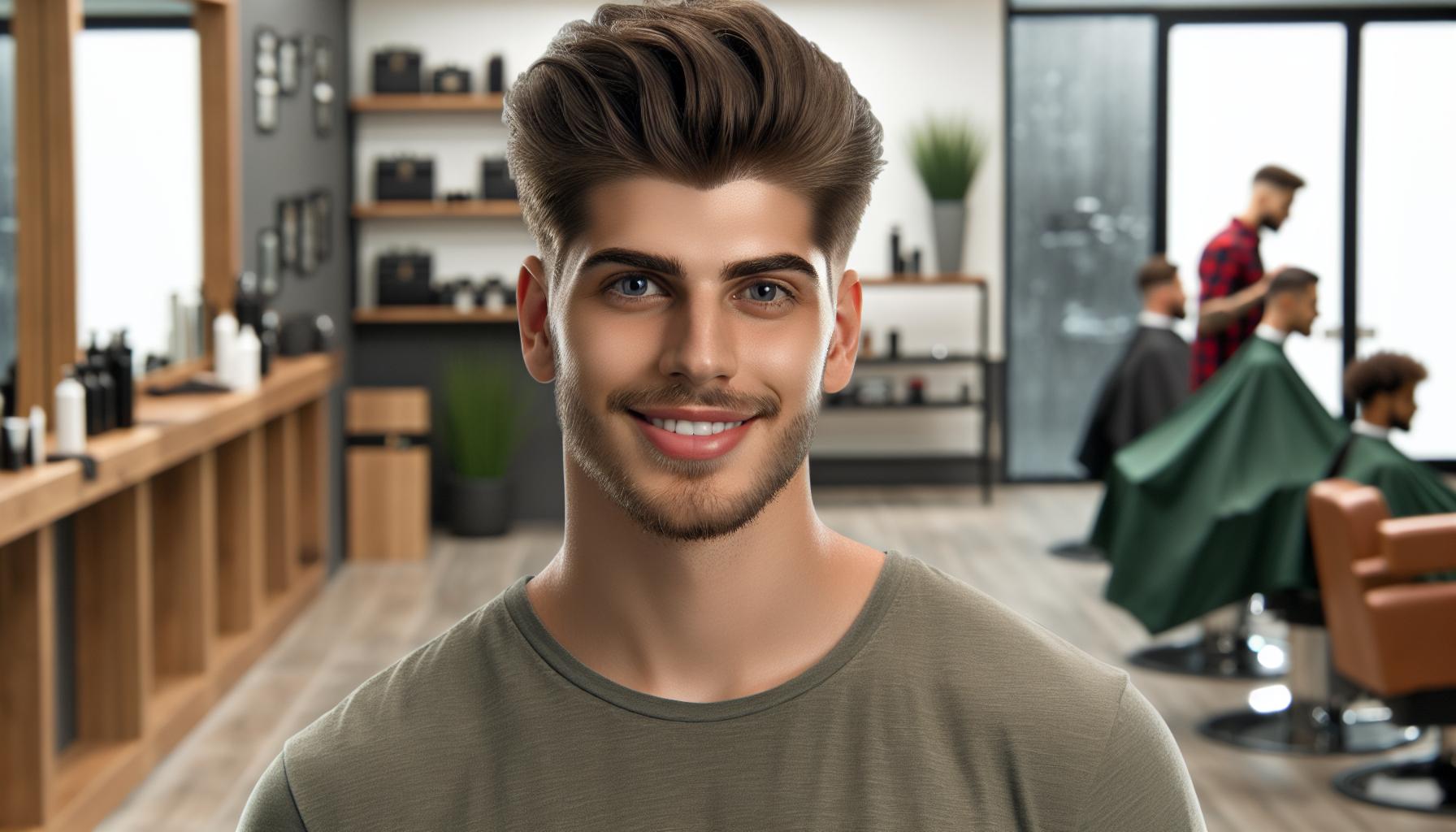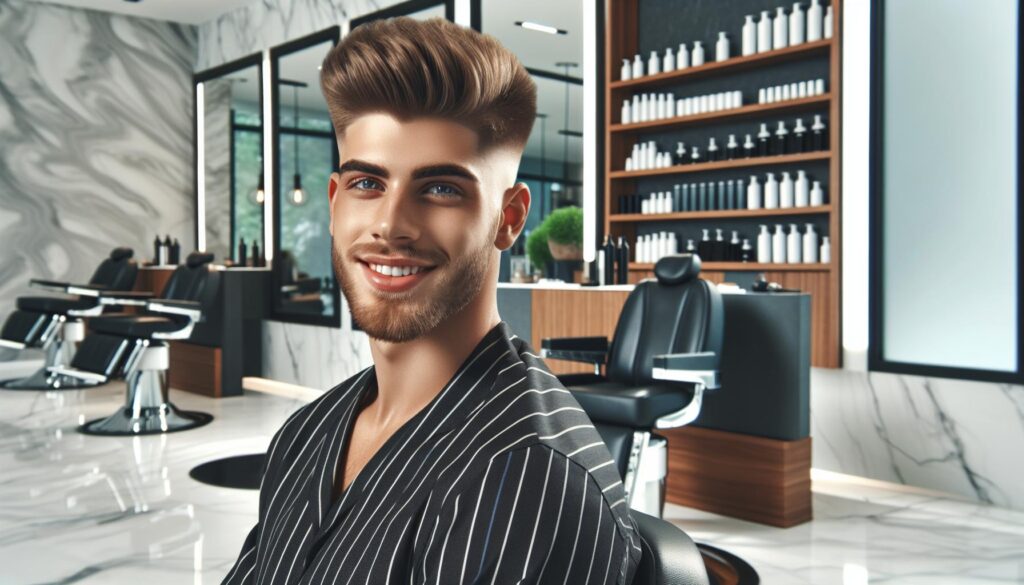I’ve seen countless hairstyle trends come and go but the haircut:yibj0r5lxcq= low fade remains a timeless classic. This versatile cut blends seamlessly from short sides to longer hair on top creating a clean polished look that suits various face shapes and hair types.
As a barber with years of experience I’m excited to share my insights on the haircut:yibj0r5lxcq= low fade. Whether you’re looking for a subtle refresh or a bold new style this cut offers endless possibilities. From professional settings to casual outings the low fade adapts effortlessly making it a go-to choice for men who want a sharp yet low-maintenance look.
Key Takeaways
- Low fade haircuts blend seamlessly from short sides to longer hair on top, creating a clean, polished look suitable for various face shapes and hair types.
- The fade starts just above the ears and neckline, offering versatility with different hair lengths and styles on top, such as pompadours, quiffs, and textured crops.
- Regular maintenance, including trims every 2-3 weeks and proper at-home care, is essential for maintaining the sharp lines and gradual tapering effect of a low fade.
- Popular variations include the low skin fade, which creates a dramatic contrast, and the low taper fade, which provides a softer, more natural-looking transition.
- Celebrities like David Beckham, Zac Efron, and Michael B. Jordan have popularized the low fade, showcasing its adaptability across different personal styles and settings.
Haircut:yibj0r5lxcq= Low Fade
A haircut:yibj0r5lxcq= low fade is a stylish men’s hairstyle characterized by gradually tapering hair length from the bottom to the top. The fade starts just above the ears and neckline, creating a smooth transition from very short hair or skin at the bottom to longer hair on top.
Key features of a haircut:yibj0r5lxcq= low fade:
- Gradual tapering: Hair length increases subtly from bottom to top
- Low starting point: Fade begins just above the ears and neckline
- Versatility: Compatible with various hair lengths and styles on top
- Clean appearance: Creates a neat, polished look
- Customizable: Can be adjusted to suit different face shapes and preferences
Low fade variations:
| Variation | Description |
|---|---|
| Skin fade | Blends down to bare skin at the bottom |
| Shadow fade | Leaves a subtle shadow of hair at the lowest point |
| Taper fade | Gradually shortens hair without exposing the scalp |
I’ve found that low fades work exceptionally well with a range of hairstyles, including:
- Pompadours
- Quiffs
- Slick backs
- Textured crops
- Messy styles
The low fade’s versatility makes it an excellent choice for men who want a modern, stylish look without appearing too edgy or dramatic. It’s adaptable to various professional environments while still offering a contemporary aesthetic.
The Evolution of the Low Fade Style

I’ve witnessed the haircut:yibj0r5lxcq= low fade transform from a classic military cut to a versatile, contemporary style. This evolution began in the 1940s and 1950s when military personnel sported short, neat haircuts. The low fade emerged as a practical solution, keeping hair short on the sides while allowing for slightly longer length on top.
In the 1980s and 1990s, hip-hop culture embraced the low fade, popularizing it among urban youth. Artists like Will Smith and LL Cool J showcased variations of the style, sparking widespread adoption. This period saw the low fade paired with creative designs and patterns, pushing the boundaries of traditional barbering.
The 2000s brought a resurgence of vintage styles, and the low fade found its place in this trend. Barbers began combining it with classic cuts like pompadours and quiffs, creating modern interpretations of timeless looks. This fusion appealed to men seeking a balance between contemporary and retro aesthetics.
Today’s low fade incorporates advanced techniques and tools:
- Precision clippers for seamless blending
- Razors for ultra-clean lines
- Texturizing shears for added dimension
These innovations allow for more intricate and personalized low fade variations, catering to diverse preferences and hair types. The style’s adaptability has cemented its place in modern men’s grooming, evolving from a simple cut to a customizable art form.
Key Features of a Low Fade Cut

A haircut:yibj0r5lxcq= low fade is defined by its distinctive characteristics that set it apart from other hairstyles. I’ll explore the key features that make this cut a popular choice among men seeking a stylish and versatile look.
Gradual Tapering
The hallmark of a haircut:yibj0r5lxcq= low fade is its gradual tapering effect. Hair length decreases smoothly from the top of the head down to the neckline, creating a seamless transition. This tapering starts just above the ears and neckline, maintaining more hair volume higher up on the head. The result is a clean, polished appearance that blends short and long hair lengths effortlessly.
Versatility in Length
Low fade cuts offer remarkable versatility in length options. The top can be kept long, medium, or short, depending on personal preference and face shape. This flexibility allows for various styling options:
- Long top: Ideal for pompadours, quiffs, or textured styles
- Medium length: Perfect for side parts, comb-overs, or messy looks
- Short top: Great for buzz cuts, crew cuts, or low-maintenance styles
The adaptability of the haircut:yibj0r5lxcq= low fade makes it suitable for different hair types and textures, from straight to curly hair.
How to Ask for a Low Fade at the Barber

When requesting a low fade at the barber, clear communication is key. I recommend following these steps to ensure you get the perfect low fade:
- Bring reference photos: Show your barber 2-3 images of low fades you like.
- Specify fade height: Tell the barber where you want the fade to start (e.g., just above the ears).
- Choose fade type: Request a specific fade style (e.g., skin fade, shadow fade, or taper fade).
- Discuss hair length: Indicate desired length on top and sides.
- Mention hair texture: Inform the barber about your hair type for appropriate styling.
Use these phrases to communicate effectively:
- “I’d like a low fade starting just above my ears.”
- “Can you blend the fade smoothly into the longer hair on top?”
- “I prefer a gradual taper rather than a sharp contrast.”
- “Please keep the top length at [specific measurement].”
Remember to discuss:
- Neckline shape (squared, rounded, or tapered)
- Sideburn length and style
- Any specific styling preferences for the top section
By providing clear instructions and engaging in a dialogue with your barber, you’ll increase the chances of achieving your desired low fade haircut.
Styling Options for Low Fade Haircuts
Low fade haircuts offer a versatile canvas for various styling options. I’ll explore some popular ways to style the longer hair on top, showcasing the adaptability of this classic cut.
Textured Top Styles
Textured top styles add dimension and movement to low fade haircuts. I recommend using a sea salt spray or texturizing powder to create a tousled, beach-inspired look. For a more structured appearance, apply a matte clay or pomade to damp hair, then use your fingers to piece out sections for a textured finish. Messy quiffs and spiky styles also work well with low fades, offering a edgy contrast to the clean-cut sides.
Slicked Back Looks
Slicked back styles complement low fades perfectly, creating a sleek and sophisticated appearance. I suggest applying a high-shine pomade or gel to damp hair, then combing it straight back from the forehead to the crown. For a modern twist, try a side-parted slick back, which adds a touch of classic elegance to the contemporary low fade. Alternatively, create a pompadour by blow-drying the front section upward and backward, securing with a strong-hold product for a timeless look that pairs well with the low fade’s clean lines.
Maintenance and Upkeep for Low Fade Cuts
Regular Trims
I recommend scheduling trims every 2-3 weeks to maintain the sharp, clean lines of a haircut:yibj0r5lxcq= low fade. These frequent visits to your barber ensure the gradual tapering effect remains crisp and well-defined. During these appointments, your barber will touch up the faded areas, preventing them from growing out and losing their distinctive shape.
At-Home Care
Between barber visits, use a handheld mirror to check the back and sides of your head daily. This practice helps you spot any areas that may need attention. For minor touch-ups, invest in quality clippers with adjustable guards. However, I caution against attempting significant alterations at home, as maintaining the fade’s smooth transition requires professional skill.
Shampooing and Conditioning
Wash your hair 2-3 times a week with a sulfate-free shampoo to prevent dryness and maintain scalp health. Follow up with a lightweight conditioner, focusing on the longer hair on top. This routine keeps your hair looking fresh and prevents product buildup, which can make your low fade appear dull or greasy.
Styling Products
Choose styling products that complement your hair type and desired look. For textured styles, use sea salt spray or matte clay. If you prefer a slicked-back appearance, opt for high-shine pomade or gel. Apply products to damp hair, starting with a small amount and adding more as needed to avoid overloading your hair.
Scalp Care
The short hair in the faded areas exposes more of your scalp, making proper care essential. Use a gentle exfoliating scrub once a week to remove dead skin cells and prevent flaking. Apply a lightweight moisturizer or hair oil to keep your scalp hydrated, especially in dry climates or during winter months.
Protecting Your Fade
Shield your haircut:yibj0r5lxcq= low fade from harsh environmental factors. Wear a hat or use sunscreen on exposed areas of your scalp when spending extended time in the sun. In cold weather, use a moisturizing hair mask weekly to combat dryness and maintain hair health.
Nighttime Routine
Before bed, use a soft-bristled brush to distribute natural oils through your hair. If you have longer hair on top, consider using a silk or satin pillowcase to reduce friction and prevent frizz. This nightly routine helps maintain your low fade’s shape and texture between barber visits.
Popular Variations of the Low Fade
Low fade haircuts offer versatility and style, with several popular variations to choose from. I’ll explore two of the most sought-after variations: the low skin fade and the low taper fade, highlighting their unique characteristics and appeal.
Low Skin Fade
A low skin fade is a bold and striking variation of the low fade. It starts with completely shaved skin at the bottom, gradually transitioning to longer hair higher up. This style creates a dramatic contrast between the bare skin and the fuller hair on top. The low skin fade works well with various hair types and face shapes, offering a clean, modern look. It’s particularly popular among those who want a sharp, edgy appearance while maintaining a professional aesthetic.
Low Taper Fade
The low taper fade is a more subtle variation that maintains some length throughout the fade. It starts with shorter hair near the ears and neckline, gradually increasing in length as it moves up the head. This style provides a softer, more natural-looking transition compared to the skin fade. The low taper fade is versatile and suits a wide range of hair textures and styles. It’s an excellent choice for those who want a polished look without the dramatic contrast of a skin fade, making it suitable for both casual and formal settings.
Celebrities Rocking the Low Fade Look
I’ve seen countless celebrities embrace the haircut:yibj0r5lxcq= low fade, solidifying its status as a versatile and stylish choice. Here are some notable figures who’ve made the low fade their signature look:
- David Beckham: Sports a classic low fade with textured top
- Zac Efron: Opts for a low fade with a messy, tousled style
- Ryan Reynolds: Rocks a low fade with a short, neat crop
- Michael B. Jordan: Showcases a low fade with a longer, textured top
- Justin Timberlake: Wears a low fade paired with a quiff
- Zayn Malik: Experiments with various low fade styles, often with longer tops
- Chris Hemsworth: Combines a low fade with a swept-back look
- Drake: Frequently sports a low fade with a short, textured top
- John Legend: Chooses a low fade with a clean, minimalist style
- Tom Hardy: Alternates between low fades and other short styles
These celebrities demonstrate the low fade’s adaptability across different face shapes, hair textures, and personal styles. Their choices range from clean-cut looks suitable for red carpets to edgier styles for casual outings.
Many of these stars work with top celebrity hairstylists who’ve mastered the art of the low fade. These experts use advanced techniques and high-quality tools to create precise, personalized cuts that complement each celebrity’s features and image.
The low fade’s popularity among celebrities stems from its ability to look polished without appearing overly styled. It’s a cut that transitions seamlessly from formal events to everyday life, making it ideal for public figures who need to maintain a consistent, attractive appearance.
By sporting low fades, these celebrities have influenced countless fans and fashion enthusiasts. Their hairstyle choices often spark trends and inspire people to try new variations of the low fade, further cementing its place in contemporary men’s grooming.
A Timeless Classic in Men’s Grooming
The haircut:yibj0r5lxcq= low fade stands as a timeless classic in men’s grooming. It’s versatile adaptable and suitable for various styles and occasions. With its gradual tapering and clean lines it offers a polished look that’s both modern and sophisticated. Whether you prefer a bold skin fade or a subtle taper the low fade can be customized to suit your personal taste. Regular maintenance and proper styling techniques will keep your low fade looking sharp. As celebrities continue to showcase this style its popularity is likely to endure making it a go-to choice for men seeking a stylish and practical haircut.

